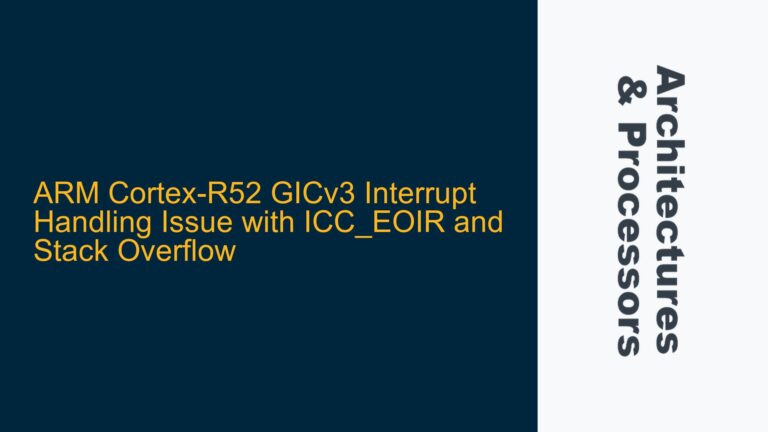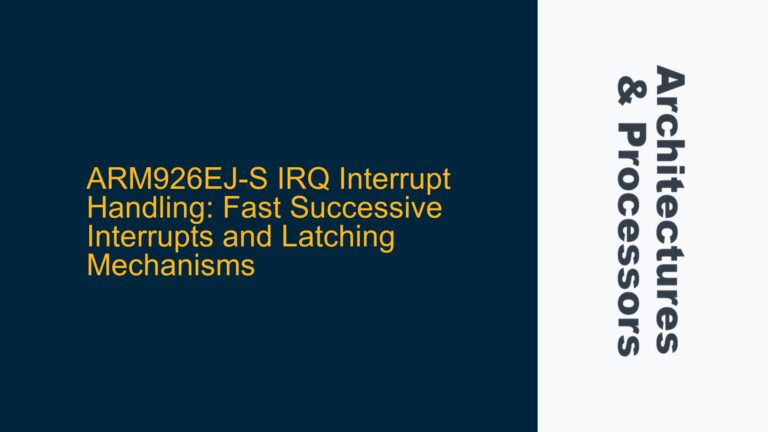ARM Cortex-M7 and Cortex-M85 FP32 Multiply-Add Throughput Discrepancies
The ARM Cortex-M7 and Cortex-M85 processors are both high-performance microcontrollers designed for embedded systems, but they exhibit significant differences in their floating-point (FP32) multiply-add throughput. The Cortex-M7, while capable, shows a throughput of approximately 5-6 clock cycles per fused multiply-add (FMA) operation when utilizing ARM libraries. This performance is somewhat underwhelming for applications requiring intensive floating-point computations, such as long-vector dot products or repeated FMA operations. On the other hand, the Cortex-M85 architecture claims improved performance, particularly for integer operations, but lacks explicit documentation on its FP32 throughput. This discrepancy raises questions about the actual FP32 performance of the Cortex-M85 and whether it can meet the demands of high-performance embedded applications.
The Cortex-M7’s FP32 performance is constrained by its pipeline architecture and the efficiency of its floating-point unit (FPU). The FPU in the Cortex-M7 is designed to handle single-precision floating-point operations, but the latency and throughput are influenced by factors such as data dependency, instruction scheduling, and memory access patterns. When performing long-vector dot products, the Cortex-M7’s performance is further impacted by the need to read data from tightly coupled memory (TCM) and the overhead associated with loop unrolling and instruction pipelining.
In contrast, the Cortex-M85 introduces architectural improvements aimed at enhancing performance, particularly for machine learning and digital signal processing (DSP) applications. These improvements include a more advanced FPU and better support for vectorized operations. However, the lack of documented FP32 throughput figures for the Cortex-M85 makes it difficult to compare its performance directly with the Cortex-M7. This absence of data is particularly concerning for developers who rely on accurate performance metrics to make informed decisions about processor selection for their applications.
Memory Access Patterns and FPU Pipeline Efficiency
One of the primary factors affecting FP32 multiply-add throughput in both the Cortex-M7 and Cortex-M85 is the efficiency of memory access patterns and the FPU pipeline. In the Cortex-M7, the FPU pipeline is designed to handle single-precision floating-point operations with a latency of several clock cycles. This latency is influenced by the complexity of the FMA operation, which involves multiple stages of computation, including multiplication, addition, and rounding. The Cortex-M7’s FPU pipeline is optimized for sequential execution, but it can suffer from stalls due to data dependencies and memory access bottlenecks.
When performing long-vector dot products, the Cortex-M7 must read data from TCM, which is typically faster than external memory but still introduces latency. The efficiency of these memory accesses is critical to achieving high throughput. If the data is not aligned properly or if there are cache misses, the FPU pipeline may stall, leading to increased cycle counts per FMA operation. Additionally, the Cortex-M7’s instruction scheduling logic must manage the flow of instructions to the FPU, ensuring that there are no unnecessary delays due to instruction dependencies or resource contention.
The Cortex-M85, with its more advanced FPU and memory subsystem, is expected to handle these challenges more effectively. The Cortex-M85’s FPU is likely designed with a deeper pipeline and better support for out-of-order execution, which can reduce the impact of data dependencies and improve overall throughput. Furthermore, the Cortex-M85’s memory subsystem may include enhancements such as prefetching and better cache management, which can reduce the latency associated with memory accesses. However, without concrete data on the Cortex-M85’s FP32 throughput, it is difficult to quantify these improvements.
Optimizing FP32 Multiply-Add Throughput on Cortex-M7 and Cortex-M85
To achieve optimal FP32 multiply-add throughput on both the Cortex-M7 and Cortex-M85, developers must focus on several key areas: instruction scheduling, memory access optimization, and leveraging hardware features such as TCM and cache management. On the Cortex-M7, developers should ensure that data is aligned properly in memory to minimize cache misses and reduce latency. Using TCM for storing frequently accessed data can also improve performance, as TCM provides faster access times compared to external memory.
Instruction scheduling is another critical factor. Developers should aim to minimize data dependencies by unrolling loops and arranging instructions to maximize parallelism. The Cortex-M7’s FPU pipeline can benefit from careful instruction ordering, ensuring that the FPU is kept busy with a steady stream of operations. Additionally, using ARM libraries optimized for the Cortex-M7 can help achieve better performance, as these libraries are tuned to take advantage of the processor’s specific architectural features.
For the Cortex-M85, developers should explore the processor’s advanced FPU and memory subsystem features. The Cortex-M85’s FPU is likely designed to handle more complex operations with lower latency, but this potential can only be realized if the software is optimized to take full advantage of these capabilities. Developers should experiment with different memory access patterns and instruction schedules to identify the most efficient configuration for their specific application. Additionally, the Cortex-M85’s support for vectorized operations may provide further opportunities for optimization, particularly in applications involving long-vector dot products or other parallelizable computations.
In conclusion, while the Cortex-M7’s FP32 multiply-add throughput is well-documented and can be optimized through careful attention to memory access patterns and instruction scheduling, the Cortex-M85’s performance remains uncertain due to a lack of published data. Developers working with the Cortex-M85 should focus on leveraging its advanced architectural features and conducting thorough benchmarking to determine its actual FP32 throughput capabilities. By doing so, they can ensure that their applications achieve the highest possible performance on these powerful embedded processors.






